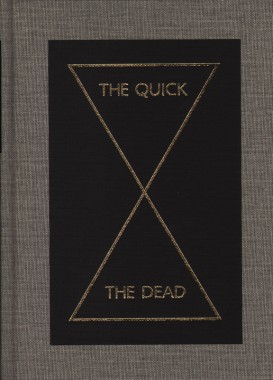
Un Coup de Dés: Writing Turned Image. An Alphabet of Pensive Language
Softcover, 250 pp., offset 4/1, 215 x 280 mm
Edition of 5000
ISBN 9783865605436
Published by Walther König
$60.00 ·
In her essay “Writing Turned Image. An Alphabet of Pensive Language,” Sabine Folie writes, “An idea…explored in Stéphane Mallarmé’s Un coup de dés (A roll of the dice) of 1897 has in the twentieth century become an integral part of the poetological and, more generally, the avant-gardist vocabulary: the idea of unmasking language as a convention whose purpose it is to discipline the individual and to subject it to a regulated system of capitalist exploitation as well as to guarantee orientation in the world… Writing was released from the textual ensemble of the book and integrated into the flow of its media — as a disturbance, a deconstruction of meaning.” The ideas of Symbolist poet and galvanizing nineteenth-century intellectual Stéphane Mallarmé are discussed in this text-heavy volume in relation to works by Robert Barry, Lothar Baumgarten, Marcel Broodthaers, Theresa Hak Kyung Cha and Rodney Graham, among others. Scholarly essays by Sabine Folie, Anna Sigridur Arnar, Jacques Rancière, Gabriele Mackert and Michael Newman accompany a generous selection of images by each of the artists.
Ana Torfs, Anna Sigridur Arnar, Art, DAP, David Lamelas, Dietrich Karner, Dominik Steiger, Ewa Partum, Gabriele Mackert, Gerhard Ruhm, Ian Wallace, Jacques Rancière, Jaroslaw Kozlowski, Joelle Tuerlinckx, Klaus Scherubel, Lothar Baumgarten, Marcel Broodthaers, Michael Newman, Peter Tscherkassky, Robert Barry, Rodney Graham, Sabine Folie, Stéphane Mallarmé, Theory, Theresa Hak Kyung Cha, Ulrike Grossarth, Walther König

Peter Eleey, The Quick and the Dead
Hardcover, 352 pp., offset 4/1, 6.75 x 9 inches
Edition of 2000
ISBN 9780935640939
Published by Walker Art Center
$45.00 ·
Artists have always used their imaginations to see beyond visible matter — to posit other physics, other energies, new ways of conceiving the visible and new models for art — but the past century has seen an explosion of such investigations. In the fashion of a Wunderkammer, The Quick and the Dead takes stock of the 1960s and 70s legacy of experimental, or “research” art by pioneers like George Brecht, who posited objects as motionless events and asked us to consider “an art verging on the non-existent, dissolving into other dimensions,” and Lygia Clark, whose foldable sculptures sought to dissolve the boundary between inside and outside, each “a static moment within the cosmological dynamics from which we came and to which we are going.” In a series of encounters with art made strange by its expansions, contractions, inversions and implosions in time and space, The Quick and the Dead surveys more than 80 works by a global, multigenerational group of 50 artists, scientists and musicians — among them James Lee Byars, Joseph Beuys, Marcel Duchamp, Harold Edgerton, Ceal Floyer, Felix Gonzalez-Torres, Pierre Huyghe, The Institute for Figuring, Paul Ramirez Jonas, Stephen Kaltenbach, On Kawara, Christine Kozlov, David Lamelas, Louise Lawler, Paul Etienne Lincoln, Mark Manders, Kris Martin, Steve McQueen, Helen Mirra, Catherine Murphy, Bruce Nauman, Rivane Neuenschwander, Claes Oldenburg, Roman Ondák, Adrian Piper, Roman Signer and Shomei Tomatsu, among many others. Includes reprints of texts by diverse luminaries such as John McPhee, Jalal Toufic, Oliver Sacks, Allan Kaprow and Robert Smithson.
Adrian Piper, Art, Bruce Nauman, Catherine Murphy, Ceal Floyer, Christine Kozlov, Claes Oldenburg, DAP, David Lamelas, Felix Gonzalez-Torres, Harold Edgerton, Helen Mirra, James Lee Byars, Joseph Beuys, Kris Martin, Louise Lawler, Marcel Duchamp, Mark Manders, On Kawara, Paul Etienne Lincoln, Paul Ramirez Jonas, Peter Eleey, Pierre Huyghe, Rivane Neuenschwander, Roman Ondák, Roman Signer, Shomei Tomatsu, Stephen Kaltenbach, Steve McQueen, The Institute for Figuring, Walker Art Center

